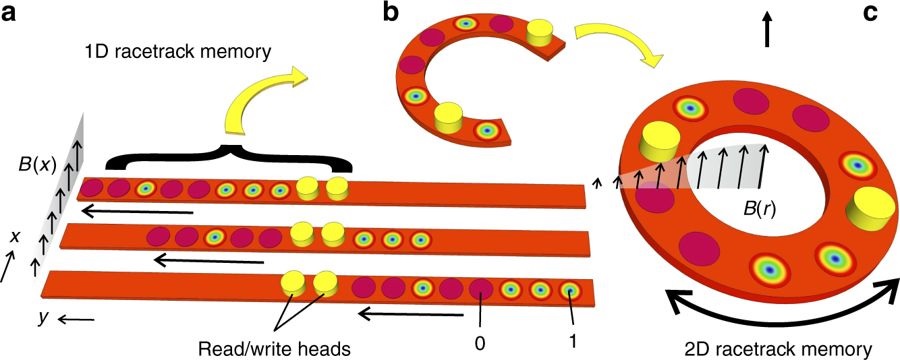
Manipulation of skyrmion motion by magnetic field gradients
D.M. Burn, S.L. Zhang, T. Hesjedal, G. van der Laan
Magnetism and Magnetic Materials Las Vegas, NV Nov 2019
Magnetic skyrmions are nanoscale, particle-like entities made up of a swirling, topologically protected spin texture which exist in chiral magnetic systems. These skyrmions are promising candidates for novel memory technologies and spintronic devices due to the potential to encode information as the presence or absence of skyrmions, allowing for a racetrack memory system [1]. Techniques to manipulate the skyrmions in such a system are key to development of such devices. Here we present a novel method to manipulate skyrmion motion using magnetic field gradients (Fig. 1) [2].
Cu22OSeO3 is a well-established skyrmion system in which individual skyrmions assemble into a closed-packed hexagonally ordered magnetic lattice [3,4]. The magnetic lattice constant is relatively large ~(60 nm), allowing for the observation of skyrmions using resonant elastic x-ray scattering (REXS). This technique is ideally suited to studying slow dynamics in situ and uses polarized soft x-rays only available at synchrotrons.
Our REXS experiments on beamline I10 at the Diamond Light Source show that the skyrmion lattice structures in single-crystal Cu22OSeO3 are highly mobile in a radial field gradient. The skyrmions rotate collectively in a shell-like structure following a given velocity-radius relationship. The direction of the field can be used to control the sense of rotation of the lattice. These results show that field gradients provide an effective mechanism for fine control of skyrmion motion. In this scheme, no local electric currents are needed, thus providing an alternative, lower energy approach to shift-register-type operations based on spin-transfer torque. Our findings open the door to a new way to manipulate and engineer the skyrmion state which will enable applications in the future.

Fig. 1. Manipulation of skyrmions along a linear racetrack and the application to a circular racetrack memory concept. (a) In a 1D linear racetrack scheme, skyrmions are moved past read/write heads collectively in a shift register fashion. (b) Morphing half of the 1D strip into a circular structure is the basis for the 2D racetrack memory element shown in (c). The required linear motion/rotation is controlled via an applied magnetic field gradient.
A. Fert, V. Cros and J. Sampaio, Nature Nano. 8, 152 (2013).
S.L. Zhang, W.W. Wang, D.M. Burn, et al., Nature Comms. 9, 2115 (2018).
S. Seki, X.Z. Yu, S. Ishiwata and Y. Tokura, Science 336, 198 (2012).
S.L. Zhang, A. Bauer, D.M. Burn, et al., Nano. Lett. 16, 3285 (2016).